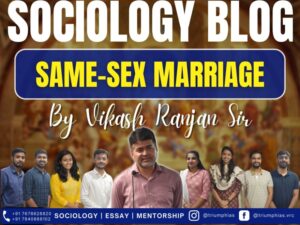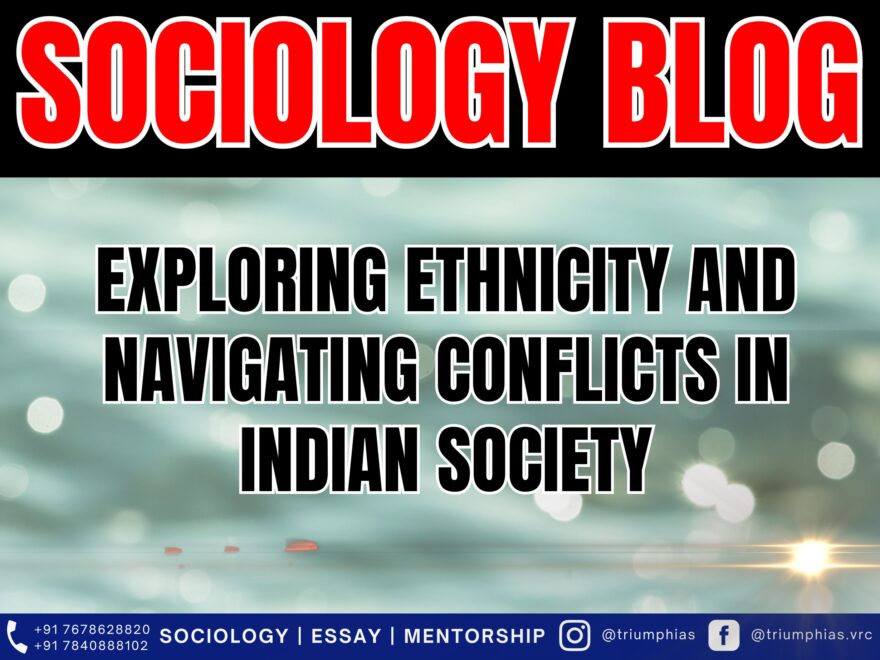Ethnicity and Navigating Conflicts in Indian Society
(Relevant for Sociology Optional for Civil Services Examination)
(Paper 2: Unit-13 Social Changes in India; Social Movements in Modern India)
Ethnicity
Across the world today, there is a serious and growing concern over the issue of ethnic relations and conflicts. India too shares this concern, as ethnic conflicts pose a serious problem in Indian society. Before we describe the nature of ethnic relations and conflicts in India, we must be clear in our minds as to what the term ethnic and other terms associated with ethnic relations mean.
- The term ‘ethnic’ is derived from the Greek word ‘ethno’ meaning ‘nation’. It was originally used to denote primitive tribes or societies that formed a nation on the basis of their simplistic forms of government and economy. In the course of time, ethnic has come to mean that which pertains to a group of people who can be distinguished by certain features like race, language or any other aspect of culture.
- Ghosh defines Ethnicity as “the process of formation and reformation of consciousness of identity (real or supposed) in terms of one or more social cultural-political symbols of domination/subjugation of a group(s) or community by another that emerge out of the processes of assimilation, acculturation, interaction, competition and conflict”.
- Ethnic group, is, therefore, defined as a cultural group whose members either share some or all of the following features—a common language, region, religion, race, endogamy, customs and beliefs. Members may also share a belief in common descent.
- Ethnic group defines an individual’s social personality. It is formed on the basis of cultural and racial uniformity. The essence of this group lies in the individual’s feeling of belongingness to it because of cultural association shared with other members. Birth determines incorporation into these groups, thereby making membership relatively restrictive. However, exception to this rule exists, for instance, in the form of conversions.
- Ethnic identity reflects both ‘likenesses and ‘uniqueness’. On the one hand, it reflects on what the members of an ethnic group hold in common, at the same time differentiating them from other ethnic groups. The representation of some of the factors of ethnic identification as arranged around the ‘self ’are Nationality, Language, Religion, Race Caste Self. For example, in India, caste happens to be an important form of ethnic identification but it is of no significance when studying a European community. Ethnic identity is imbibed among the members of ethnic group by in group socialisation, in group interaction, in group residential pattern, economic organisation etc.
- Ethnicity as a cultural phenomenon and as such no culture is “superior” or “inferior”. Culture belongs to a people, and they endear it like any other people. B. Tylor defined culture as “that complex whole which includes knowledge, belief, art, morals, law, custom and any other capabilities and habits acquired by man as a member of society”. “Culture is the man-made part of the environment”. Therefore, all ethnic entities are cultural groupings, and they enjoy the same position in terms of the normative orientations of different sets of people.
Ethnic Conflict
An ethnic group may think that it is a living being of a unique kind. Its members generally think in terms of a real or factious commonality based on common ancestral, cultural heritage, language, religion and even economic interests. Internally, all ethnic groups are stratified despite their claim of commonality in all respects. Ethnicity has become a very sensitive aspect of India’s social fabric, resulting in ethnic cleavage, conflict, violence and hatred. A plural or multi-ethnic society like India would have an overlapping of ethnic, caste and class groupings. Continuity of these groupings is important to distinguish among ethnicity, caste and class; as three bases of social ranking and identification.
Common Features of Ethnic Conflicts
- Ethnic conflicts are a consequence of organised communal bodies. For the conflict to become a public issue, usually the organised bodies, which are backed by political parties, have to come to the fore. Thus communal bodies become institutionalised.
- Ethnic conflicts indicate that whatever be the manifest cause – language, region or religion – the latent cause is not rooted in cultural disparity. Conflicting economic and political interests form the basis of the latent cause. The tensions generally arise when a minority group feels deprived of an equal position in either the economic or political sphere as compared to the majority group, uses the primary ties to motivate and activate their ethnic group against the dominant group. For instance, the Hindu Sikh conflict was between peoples who were not culturally different, but rather were well-assimilated group.
- Thus, we may say, that ethnic conflicts arose not because of some common goals but because of conflicting interests. The allegiance or the basis of group loyalty depends on the principle of mutual interest. For instance, during the 1972 Assam riots, the Bengali Muslims, who share cultural similarities with Bengali Hindus did not side with them, instead they supported the Assamese in exchange of not being ousted from their land, by the politically active Assamese.
Theoretical strands associated with ethnic conflict:
|
Dimensions associated with Ethnic Conflict:
- Economic Disparity: The major cause of ethnic conflict is economic disparity, disparity in life chances. Because of low rate of economic development, slow economic differentiation and high volume of population and increased density of population, competition for resources among ethnicities have increased. This at times leads to conflict.
- Poor governance and misdistribution of resources: These have become potent causes of ethnic disaffection, Demographic pressures, a change in the distribution of power within an ethnic community, or political competition among leaders and parties can change the position of an ethnic group within India’s polity, leading to conflict.
- Historical differences: Historical differences between ethnic groups have been intensified by factors such as hold over government, struggle for jobs, land scarcity, and population influx.
- Language conflict: Language conflict has been a cause of ethnic conflict in India. Language has always been a cornerstone of ethnic identity. Every ethnic group has its own language and the members of ethnic group build their ethnic identity through their own language. For Example the Dravida Kazhagam movement took shape in Tamil Nadu in 1940s and 1950s. In this movement there was a strong opposition from the Dravidian language speakers against the adoption of Hindi as the national language by the government of India.
- Vanaik says linguistic ethnicity came into existence in India along with the growth of the national movement. He says for most Indians, linguistic consciousness coexists non-antagonistically with national consciousness.
- K. Oommen writes comparing language and religion, he says that language has more legitimacy than religion for administrative restructuring
- Religious conflict: Religious conflict has also been a cause of ethnic conflict in India, as seen in the Hindu-Muslim conflict. When ethnic groups try to establish their identity through religion, they breed conflict and threaten the community life. History reads that communalism has been a major source of communal conflict in the country. Bipan Chandra holds that communalism in India is a modern phenomenon. It has its roots in British imperialism and emerged out of modern politics based on mass mobilization and imaginary communal interests.
- Majority-Minority Disparity: D. L. Sheth points out that specific minorities have achieved greater progress than the majority in terms of development. These minorities believe they could excel further if their prospects weren’t hindered. This creates relative deprivation and hence conflict arises. The recent conflict in Manipur highlights how majority group felt the fear of being reduced to minority if protection of ST status not provided to them.
- Homogenizing Tendencies Of Modern States: According to Rajni Kothari, ethnic upsurges in India can be attributed to the homogenizing tendencies of modern states and their emphasis on technological and educational imperatives.
- Fluidity in Character of Ethnicity: James Manor has highlighted fluidity in character of ethnicity. For example a strong sub- regional movement had taken shape against the alleged unjust treatment by the state People in Punjab, for instance, have shifted their pre-occupation with linguistic identity. (Demand for autonomy based on language in 1960s) to regional (conflict with the Center in the 1970s), religious (demand for separate state of Khalistan in the 1980s).
- Cross border ethnic ties: The acceleration of international migration has led to the emergence of multi-ethnic societies. These diverse communities are influenced by globalization, which affects them in ways that go beyond local boundaries. The demands for Tamilians in Tamil Nadu for state interference for protection of Tamils in Sri Lanka creates a complex situation.
- Ethno-Nationalism: Ethno-nationalism involves ethnic groups, such as Muslims, Shikhs emphasizing exclusive identification with their country based on shared elements like ancestry, race, culture, history, and language. This can lead to disparities in access to opportunities and resources. The demand of Greater Nagalims is an issue associated with ethno nationalism . K N Panikar says periodically ethnic identities and loyalties surfaced in Indian polity , using different strategies and methods. Unfortunately, the state responded to aspirations of these marginalised groups by method that relied more on force , and this led to greater alienation of these communities.
- Ethnic Cleansing: In interethnic conflicts, the native ethnic group may commit acts of genocide or expel foreigners, as exemplified by the ethnic cleansing of Kashmiri Pandits from Kashmir.
- Ethnic Dynamics: India faces challenges stemming from ethnic categorizations, including autonomy movements, separatist endeavours, insurgency, and violent conflicts rooted in identity markers such as language, religion, caste, and tribe. The demand for autonomous districts and devolution of power by Bodos and Gorkhas shows complex sub ethnicity related dynamics in these areas.
- Constitutional protection: the ethnic groups present in country are again withhold multiple diversities among them. They are sometimes religiously different , sometime linguistic differences are there. This further creates demand for constitutional protections like inclusion of language in 8th schedule etc. Such demands further leads to sub ethnic conflicts. This can also explain the rise in demand of SC status and positive affirmation for Dalit Christians and Muslims.
- Demand for separate identity from main stream groups: sometime various subsections demands for separate identity from their mainstream identity due to their strong mechanical solidarity within group. Demand for status of different religion by Lingayat outside Hinduism highlights this aspect. Fredrik Barth’s theory of ethnic boundaries which emphasizes the role of self-defined distinctions in preserving unique cultural identities within sub-ethnic divisions can explain such behaviour.
- Developmental deficit: Some sub ethnic groups are different in character, culture, primitiveness and backwardness from other counterparts. Hence feel more developmental deficit. Such groups need separate and tailored state intervention. The identification of PVTGS and special policy formation for them highlights the acceptance of such diversity by state.
- Politicization: Dipankar Gupta argues that the manifestation of ethnicity in Indian politics is not so much an outcome of popular grass-root passions as it is a creation of vested political interests. He applies the notion of ‘conspiracy’ to ethnic politics in India to draw attention to the deliberate and calculated manner in which such politics is fashioned. Cohen suggests that ethnicity doesn’t necessarily require cultural or historical explanations; contemporary politics and prevailing structural conditions are the primary factors for understanding this phenomenon.
Solutions to Ethnic Conflict
- Ashutosh Varshney, in his 2001 article “Ethnic Conflict and Civil Society: India and Beyond,” argues that certain towns, cities, areas, and localities are more susceptible to ethnic conflicts. Therefore, addressing ethnic conflicts requires a micro-level approach.
- Instead of solely focusing on national-level structures, efforts should concentrate on improving inter-ethnic relationships at the local level. Varshney contends that robust inter-ethnic engagement in local communities, such as villages, discourages politicians and other vested interests from exploiting ethnic violence for electoral gain.
- Fortunately, despite numerous obstacles, most ethnic groups in India have maintained their trust in the electoral and democratic process. This trust has significantly contributed to India’s ability to remain united as a nation for over seventy years.
Manifestation of Ethnic Conflict:
Ethnic conflicts can manifest in various ways, often involving tension, violence, and discrimination between different ethnic groups. The manifestations can vary in intensity and scope, but they generally share common characteristics.
Here are some key manifestations of ethnic conflicts:
- Violence and Warfare: Ethnic conflicts often escalate into armed conflicts, ranging from localized clashes to full-scale civil wars. These conflicts can result in significant loss of life and property damage.
- Discrimination and Marginalization: Discrimination against ethnic minorities can be both institutional and societal. Discriminatory policies and practices can limit the rights, opportunities, and access to resources for specific ethnic groups.
- Hate Speech and Propaganda: Ethnic conflicts are often fuelled by hate speech, propaganda, and incitement to violence. Media outlets and political leaders may use inflammatory rhetoric to manipulate public opinion and incite violence against particular ethnic groups.
- Forced Displacement and Refugees: Ethnic conflicts frequently lead to the displacement of people from their homes. This can result in both internal displacement (IDPs) and cross-border refugee flows, creating humanitarian crises.
- Ethnic Cleansing and Genocide: In extreme cases, ethnic conflicts can escalate to ethnic cleansing or genocide, where one ethnic group seeks to eliminate or forcibly remove another group from a specific territory. The intent is to ethnically homogenize the region.
- Terrorism and Insurgency: Ethnic conflicts can give rise to terrorist organizations and insurgent groups that use violence as a means to achieve their ethnic or political goals.
- Separatism and Secession: Ethnic conflicts may lead to movements advocating for autonomy, independence, or secession from the state in which the conflict occurs. These movements seek to establish their own ethnic-based political entities.
It’s important to note that ethnic conflicts are complex, with underlying historical, economic, political, and social factors that contribute to their emergence and perpetuation. Addressing ethnic conflicts typically requires a comprehensive approach that considers these multifaceted causes and seeks to promote reconciliation, inclusivity, and sustainable peace.
Frequently Asked Questions:
1. Question: Define ethnicity in the context of Indian society.
Answer: Ethnicity in the context of Indian society pertains to the identification with and feeling of belongingness to groups distinguished by shared cultural practices, linguistic affiliations, religious beliefs, and sometimes racial and ancestral ties, leading to the formation of an individual’s social personality and identity.
2. Question: Explain the role of economic disparity in ethnic conflicts in India.
Answer: Economic disparity plays a pivotal role in fomenting ethnicity conflicts in India, wherein the uneven distribution of resources and opportunities among various ethnic, caste, and religious groups leads to discontent, competition, and sometimes violent confrontations, as marginalized groups seek to assert their rights and access to resources, while dominant groups strive to maintain their privileged status.
3. Question: How does the plural nature of Indian society contribute to heightened ethnicity?
Answer: The plural nature of Indian society, characterized by an extensive diversity across castes, religious groups, linguistic communities, and cultures, creates a vibrant yet complex tapestry where varied groups aim to preserve their distinct cultural heritage while concurrently engaging in intense competition for limited economic resources, thereby contributing to heightened ethnicity and, at times, conflict.
4. Question: How have historical differences and demographic pressures intensified ethnic conflicts in India?
Answer: Historical differences, demographic pressures, and shifts in power distributions among ethnic communities have intensified ethnicity conflicts in India by reviving old animosities and creating scenarios where competition for resources, political power, and social status escalates, thus leading to disaffection and sometimes violent confrontations among the various ethnicities cohabiting in the nation.
5. Question: What is the role of language conflict in promoting ethnic identity and causing dissonance in Indian society?
Answer: Language conflict, stemming from the strong identification of linguistic groups with their specific languages, plays a crucial role in promoting ethnic identity and can cause dissonance in Indian society when there is perceived marginalization or suppression of a linguistic group’s rights and cultural practices, as observed in various anti-Hindi agitations and movements in non-Hindi speaking regions like Tamil Nadu.
Reference: Static Portion
Related Blogs …
 |
 |

To master these intricacies and fare well in the Sociology Optional Syllabus, aspiring sociologists might benefit from guidance by the Best Sociology Optional Teacher and participation in the Best Sociology Optional Coaching. These avenues provide comprehensive assistance, ensuring a solid understanding of sociology’s diverse methodologies and techniques.
META TAGS:
Ethnicity and Navigating Conflicts, Ethnicity in sociology, ethnicity in sociology upsc, ethnicity in india, ethnicity in indian society, ethnicity in manipur, Ethnicity, Ethnic Conflicts, Indian Society, Economic Disparity, Religious Conflict, Language Conflict, Cultural Diversity, Social Identity, Ethnic Groups, Caste System, Assimilation, Acculturation, Minority Groups, Political Manipulation, Historical Differences, Economic Development, Governance
Why Vikash Ranjan’s Classes for Sociology?
Proper guidance and assistance are required to learn the skill of interlinking current happenings with the conventional topics. VIKASH RANJAN SIR at TRIUMPH IAS guides students according to the Recent Trends of UPSC, making him the Best Sociology Teacher for Sociology Optional UPSC.
At Triumph IAS, the Best Sociology Optional Coaching platform, we not only provide the best study material and applied classes for Sociology for IAS but also conduct regular assignments and class tests to assess candidates’ writing skills and understanding of the subject.
Choose The Best Sociology Optional Teacher for IAS Preparation?
At the beginning of the journey for Civil Services Examination preparation, many students face a pivotal decision – selecting their optional subject. Questions such as “which optional subject is the best?” and “which optional subject is the most scoring?” frequently come to mind. Choosing the right optional subject, like choosing the best sociology optional teacher, is a subjective yet vital step that requires a thoughtful decision based on facts. A misstep in this crucial decision can indeed prove disastrous.
Ever since the exam pattern was revamped in 2013, the UPSC has eliminated the need for a second optional subject. Now, candidates have to choose only one optional subject for the UPSC Mains, which has two papers of 250 marks each. One of the compelling choices for many has been the sociology optional. However, it’s strongly advised to decide on your optional subject for mains well ahead of time to get sufficient time to complete the syllabus. After all, most students score similarly in General Studies Papers; it’s the score in the optional subject & essay that contributes significantly to the final selection.
“A sound strategy does not rely solely on the popular
Opinion of toppers or famous YouTubers cum teachers.”
It requires understanding one’s ability, interest, and the relevance of the subject, not just for the exam but also for life in general. Hence, when selecting the best sociology teacher, one must consider the usefulness of sociology optional coaching in General Studies, Essay, and Personality Test.
The choice of the optional subject should be based on objective criteria, such as the nature, scope, and size of the syllabus, uniformity and stability in the question pattern, relevance of the syllabic content in daily life in society, and the availability of study material and guidance. For example, choosing the best sociology optional coaching can ensure access to top-quality study materials and experienced teachers. Always remember, the approach of the UPSC optional subject differs from your academic studies of subjects. Therefore, before settling for sociology optional, you need to analyze the syllabus, previous years’ pattern, subject requirements (be it ideal, visionary, numerical, conceptual theoretical), and your comfort level with the subject.
This decision marks a critical point in your UPSC – CSE journey, potentially determining your success in a career in IAS/Civil Services. Therefore, it’s crucial to choose wisely, whether it’s the optional subject or the best sociology optional teacher. Always base your decision on accurate facts, and never let your emotional biases guide your choices. After all, the search for the best sociology optional coaching is about finding the perfect fit for your unique academic needs and aspirations.
Follow us :
🔎 https://www.instagram.com/triumphias
🔎https://www.youtube.com/c/TriumphIAS
🔎https://t.me/VikashRanjanSociology
Find More Blogs
| Compare and contrast Karl Marx’s and Max weber’s | Karl Marx- Historical Materialism |
| Position of Women In the Modern Indian Society | Sociology: Social system and pattern variables |





3 comments